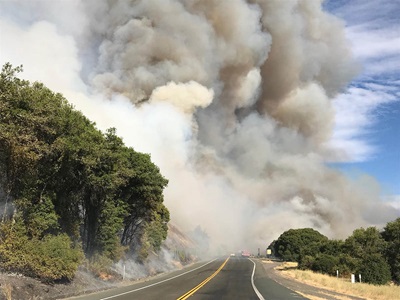Smoke from the Mendocino Complex fires, as well as other California wildfires, poured into the air. Photo by District 1 
By Cori Reed
District 1 Lake and Mendocino county Public Information Officer
It is a record that no one wants to break - the largest wildfire in California's recorded history. The Mendocino Complex Fire achieved that title on day nine. At day 18, the blaze totaled 344, 890 acres. The Thomas Fire in Santa Barbara and Ventura counties last December held the record previously at 281,893 acres. As of Sept. 6, the Mendocino Complex fire was 98 percent contained and had burned 459,123 acres.
The Mendocino Complex Fire was actually two separate fires: the Ranch and River Fires. One burned to the north and east of Clear Lake, the other to the west. While the two blazes had not united as of Sept. 6, they broke out an hour apart on July 27 and fire officials treated them as one event. At the height of the fire activity, approximately 12,000 residents were under evacuation orders and 6,000 were under evacuation advisory. The fire, while massive, destroyed far less property than other recent infernos. By comparison, the Mendocino Complex Fire burned mostly into forest area and away from homes. A total of 280 structures were lost and one fatality was reported so far. The Thomas Fire destroyed 1,063 structures and had two fatalities.
The smaller of the two, the River Fire, closed State Route 175 on July 28 within 24 hours after it started. This curvy mountain road is a popular short cut to get from Lake County to Hopland and U.S. Highway 101. The fire burned on both sides of the road and destroyed miles of guardrail and signs and damaged trees and culverts. The River Fire is contained and has burned 48,920 acres. State Route (SR) 175 was the first of the three highways to reopen on Aug. 3 after being closed for seven days.
The larger Ranch Fire closed SR-29 and SR-20 on July 29. These two highways provide a vital east-to-west connection for motorists traveling between U.S.-101 and Interstate 5. The fire jumped the highways at several spots and burned both sides. The fire left miles of destruction in the form of burned houses, signs, trees, guardrails, culverts, utility poles and more. The highways were stained red from all the fire retardant in the days following the major fire activity.
Caltrans maintenance crews were out on the scene from the very beginning of these fires. The crews set up the roadblocks on routes 175, 29, and 20 at multiple points. They provided assistance to the California Highway Patrol and fire crews by directing traffic. The roadblocks were staffed 24 hours a day for almost 12 days. Crews worked 12-hour shifts with no days off since the fires started. Many of them had been away from their families, and in some cases not sure if their own homes were safe. In addition, there were several air quality alerts in effect for Lake County during this time. The conditions ranged from "unhealthy "to "very unhealthy" for several days.

Everything was destroyed, blackened and/or warped from the heat of the fire.
Photo by District 1
The River Fire died down enough to open SR-29 on Aug. 4. Some evacuations were lifted and cities began to repopulate. It was another four days before the Ranch Fire changed course and stopped threating SR-20. Once the flames diminished, Caltrans tree and maintenance crews worked around the clock to make sure the highway would be safe to travel once Cal Fire and all the agencies agreed.
On Aug. 8, SR-20 opened after 11 days of being closed. The fire danger was still there, but it was burning away from the highway and residential areas. On August 16, the Ranch Fire was burning in the Snow Mountain Wilderness. On its own, the Ranch Fire ranks as the second largest California wildfire at 295,970 acres, having surpassed the December 2017 Thomas Fire.
The collaborative efforts of all agencies involved were amazing during this peak fire activity – and continue to be so. The teamwork within Caltrans was no exception. The Ukiah Maintenance Yard lost power during the early days of the fire, and Caltrans District 3 provided a generator to help keep District 2 going. At one point, the Ranch Fire was burning just two miles from the Clearlake Oaks Maintenance Yard, and staff and equipment were moved and staged in nearby yards. This staging happened multiple times over the next 11 days as the fire changed directions. District 3 brought their Caltrans Satellite Communication (SATCOM) Trailers to the Ukiah Maintenance Yard in case emergency communications were needed.
District 1's SATCOM trailer was in District 2, helping crews working on the Carr Fire. District 7 safety officers drove their safety van all the way up to District 1 from Los Angeles and stayed for four days. The safety vans are mobile storehouses stocked with personal protective equipment, including respiratory and heat illness protection, safety glasses and vests, water, and food. The cooling neck towels were among the most popular items with temperatures in the triple digits most of the time. District 7 safety officers worked with the District 1 safety officer to stock and support the Caltrans crews working in the fire zone.
A $10.5 million emergency contract was awarded Aug. 2 to begin repairs on SR-175 and SR-20. Preliminary estimates list more than 6,000 feet of guardrail to be replaced, as well as damaged signs, drainage systems, slopes and other infrastructure. While the fire is nearly contained, the damage to the roads and these communities will last for years. Unfortunately, fire disasters are becoming a way of life for Northern California. Response agencies learn more during each wildfire and improve collaboration and response efforts, but wish those skills weren't needed so frequently.

